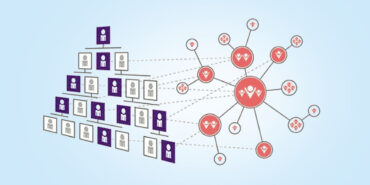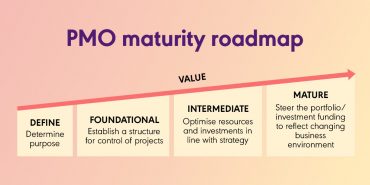Why your organisation needs better benefits management (and how to improve your practices)

Benefits realisation is the defining factor in project success and the real purpose for the implementation of projects, but many organisations fail to focus enough effort on benefits management. Here, Senior Consultant Steve Vanges discusses this crucial conundrum and offers his tips on how you can improve your benefits management practices.
Projects exist to create benefits, regardless of the size, complexity or delivery approach (waterfall/ hybrid).
Benefits management is the process of tracking and estimating the value to be delivered by performing a project and then measuring the value realised at one or more intervals during the project, and/or after the project has completed.
Executing projects without benefits management runs the risk of investing in projects that do not deliver value to the organisation, and/or missing opportunities to incorporate value delivered by projects into your ongoing organisational planning. Likewise, formal benefits management directly correlates with achieving strategic goals. In its 2020 Project Management Survey, for instance, the Australian Institute of Project Management found that organisations with these practices in place were more likely to deliver successful projects.
Struggling to deliver benefits
If benefits realisation and management is so pivotal, why are project teams, PMOs and investment governance teams failing to embed benefits management in the way projects, programmes and project investment portfolios are run?
A global Project Management Institute Pulse of the Profession report revealed that only 35 per cent of respondents characterised the benefits realisation process management maturity of their organisation as ‘high’ and less than half (47 percent) used standardised project management practices for benefits realisation management.
According to the AIPM’s 2021 survey, one in 10 project managers were ‘unsure of benefits that their organisation’s projects generally achieved’ and 18 per cent estimated that their projects realised less than half of their benefits.
Australian project managers are not alone: a UK study found that three in five organisations struggled to ‘mostly or always deliver the full benefits of their projects’ and identified benefits realisation as the most challenging aspect of project and portfolio management.
Understanding benefits management
Many organisations make the mistake of focusing too much of their attention on project outputs, and in the process, project benefits are sidelined. With this in mind, a key distinction needs to be made between the two:
- Project outputs are the things that are created: usually assets, controls, behaviours, conditions or effects.
- Project benefits are the measures of changes that result from a project. While these are frequently measured in terms of dollars they are underpinned by an observable and measurable change.
As an example, if the ‘output’ is a new road on a mining site, the benefits could include:
- An increase in safety – measured in the frequency and severity of incidents
- Improved wellbeing for neighbouring sites due to reduced particulate (e.g. dust) pollution – measured in the amount of dust deposited off site
- The ability for road-users to access a new location, potentially also enabling further benefits for revenue uplift due to increased production capacity or new products
- A reduction in commuting time, potentially also enabling further benefits for cost reduction and/or increased productivity.
How to improve your benefits management
Below are my top 8 tips on how to improve benefits management for your project, portfolio and organisation:
1. Build the business case around benefits
Project benefits, not deliverables, are the sole justification for a business case.
The purpose of the project must be enabled by the benefits it seeks to deliver. Many projects struggle to define clear benefits statements, which can be one indictor the project justification is not strong. When defining a benefit statement, ensure both the specific benefit area, measure (KPI), measurement approach, current baseline, target change quantification (estimate), and owner (more on owner later) are included where possible.
2. Do not maximise benefits on each project, instead optimise benefits across the portfolio
Project benefits targets must consider the cost to achieve them.
Understanding value is a crucial element of successful benefits management. To this end, focus on benefit optimisation, not necessarily maximisation – this approach considers constraints and potential other uses of funding. Settling on realising 80 per cent of potential benefits for an initiative may, for example, be greater value for money than spending 40 per cent of the budget to achieve the last 20 per cent, particularly where these funds can be invested in a different project to yield higher benefits return. In some cases, benefits management may also reveal when it is better to close out a project early, prompted by the question: if the project will no longer achieve X benefits, is it still worth delivering?
3. Perform active project value management
Benefits impacts must drive project decision-making.
The onus is on the project sponsor and project owner to ensure benefits management underpins every project discussion and that benefits are understood, identified, documented and reported. When there are changes to the project scope, quality, cost or schedule, the project owner must ensure the impacts on how this might affect the project’s ultimate value are tracked in order to influence project decisions.
4. Ensure continuous benefits management
Benefits management is not a ‘set and forget’ activity during the project lifecycle.
After documenting expected benefits in their business case, a common project error is to forget about benefits realisation until the closure phase of a project. A more effective approach is to perform regular reviews to check whether the key enablers of benefits are on track to deliver them. Are there any threats to achieving benefits? Are any new potential benefits emerging? Not all benefits are apparent or quantifiable at the start of a project and being able to pursue worthwhile opportunities over the lifecycle is also an aspect of benefits management.
5. Assign a benefits owner
Benefits without an accountable owner are akin to hollow promises.
For in-house projects the project owner and the benefits owner are generally one and the same. Sometimes, however, they are different people. In this scenario, it’s essential that the benefits owner is engaged early in the project lifecycle and has an active role in defining the project benefits.
This approach ensures the benefits forecasts described by the project are in line with the expectations of the benefits owner who will be held accountable for the realisation of these benefits post project.
6. One benefit area, one project delivering change
Limit the number of projects concurrently impacting the same benefit areas wherever possible.
When multiple projects impact the same benefit area around the same time, it is frequently difficult to isolate the extent to which each individual project caused a change in benefits – positive and negative. One approach to remediating this challenge is to bundle all work impacting a single benefit area into the same project, ensuring a single point of accountability (project sponsor) and responsibility (project owner). Another approach is to further decompose stated benefits into lower level measures for tracking purposes, while still retaining higher level measures (e.g. financials) for consistency.
7. Transition benefits to operations
Benefits must be transitioned to operations in a similar manner to how roles, processes, systems and data are transitioned.
Transitioning benefits to operations ensures ownership post-project closure. This process is comprised of assigning an accountable owner (which may be the project owner depending on circumstances) as well as adjusting future budgets to embed the benefits forecast. When integrating benefits forecasts into budgets, it is advisable to keep a record of cumulative adjustments linked to the source benefit in order to inform where benefits are being derived from.
8. Extend benefits realisation tracking beyond the project
Many project benefits are generally realised after the project closes and require active tracking outside the project construct.
Many benefits will be realised in the future well after the project team has captured its ‘lessons learnt’; a new road in year one might precipitate economic prosperity for a township in year five. Project-led organisations should consider tracking benefits after project completion to better evaluate project success. This can help with knowledge management and inform future projects with regard to resources required and cost-value propositions.
Managing benefits is one of the most important areas of project management, yet also one of its most challenging aspects. Placing benefits management at the forefront of project decision-making helps to define both the project objectives and its success factors. With more attention, skills and focus on learning and continuous improvement of these practices, benefits management can enhance project management as a whole and ultimately deliver more measurable value for your organisation.
Looking to sharpen benefits realisation in your project? PM-Partners can assist you with your current project or help you improve your benefits management skills. Contact PM-Partners or phone 1300 70 13 14 for expert advice.

About The Author
Steve Vanges
Senior Consultant, PM-Partners
A highly experienced PMO, transformation, programme and project specialist, Steve has a proven track record of building, improving and running PMO teams to accelerate business strategy aligned benefits realisation and project delivery capability for the likes of NBN, Ausgrid, Caltex, Royal Institute for Deaf & Blind Children and Foxtel.
Among his areas of specialty, Steve has extensive experience designing, delivering and embedding process, controls, information, systems and people change across a broad range of business sectors. This includes working with IBM, Deutsche Bank, ParcelDirect Group and Leighton Group.








